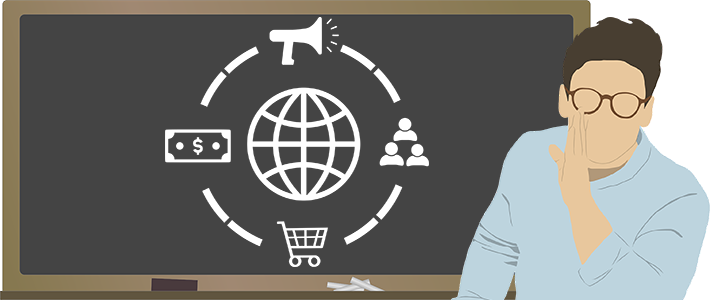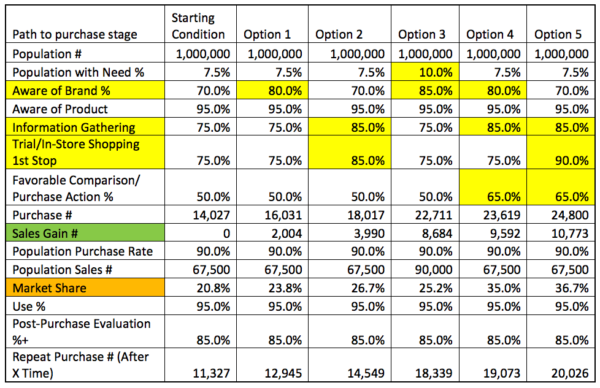What Does a Marketer Need to Know?

Marketing managers aren’t just focused on their product. They are constantly having to make decisions about what products or services to buy to help sell their product. It all ties back to the end customer. What does it take to get the end customer to choose one product over five other comparable products?
Set aside decisions about the product to focus on decisions about marketing communications. Every advertising medium sales representative attempts to claim a share of the advertising budget and wants more. Budgets are tight, with no room for waste. Choices must be made.
What is the purchase-decision process that buyers of your product go through? If you can map the path to purchase with a sense of information needs/absorption, sourcing and timing, you can fairly evaluate the productivity of each possible component in the communications budget. The objective is to have measurable goals for every expense.
Most products are established in consumers’ minds at least as a category, if not as a brand or a product. What, then, is the generic path to purchase for a product in your product category? How do you make use of knowing that path to make budget allocations? Here is a demonstration worksheet that helps reveal the marginal benefit of a dollar spent in any communication:
Path to Purchase Goal Setting Worksheet

The magnitude of the business opportunity is the starting point. Of the 1,000,000 households, it is estimated that only 7.5% feel a need for the product category at any given time, and only 90% follow through with a purchase. The effectiveness and efficiency of marketing efforts depend upon the ability to target communications to the 75,000 households actively in the market at any given time. If no targeting is attempted, 92.5% of any communications expenditures are mostly wasted. Even narrowing the reach to 150,000 households represents a significant savings.
The above worksheet demonstrates how a marketing manager can estimate the value of doing something to change consumer behavior at any point on the path to purchase. Option 1 shows that increasing brand awareness alone from 70% to 80% would increase sales by 2,004 units. An easy multiplication of units times margin nets the limit on how much it would be worth raising awareness an additional 10%.
Option 2 accepts the brand and product awareness levels and attempts to use communications to increase information gathering and trial/in-store shopping 1st stop behaviors. This would largely mean using various media to stimulate web visits to gather information, SEO performance boosting, website content viewing/click-through behavior, and past customer favorable testimonials, which for many are becoming a substitute for first-hand product trial. Compared to Option 1, it is likely that this option is more cost efficient and appears to be more productive than boosting brand awareness alone. It is predicted that these efforts would result in an additional nearly 4,000 units being sold.
Option 3 puts all the effort into boosting consumers’ perceived need for the product, while also raising brand awareness. This effort would probably involve reaching beyond the established customer market segments. It would be costly. The company would probably only capture 38.6% of the total increase in product category sales. In general, this is probably why few businesses engage in product category boosting campaigns for established products.
Option 4 works to raise brand awareness, leaving the product awareness rate among those aware of the brand constant, and then works on information gathering and favorable comparison/product selection behavior. Influencing information gathering and product evaluation are key strategic goals when the differences between competing products are qualitative attributes. Communications can be used to raise the profile, importance and value of small differences between competing products. These efforts, to the extent possible, should be targeted toward active shoppers or those anticipated to be in the market.
Option 5 accepts the brand and product awareness levels and puts all the effort into information gathering, trial/1st stop shopping intent, and product comparison/purchase selection. If the communication goals are achieved on a targeted basis, it is likely that this strategy will achieve the greatest sales gains more cost effectively than any other strategy combination.
In this example, the post-purchase evaluation phase is left uninfluenced. If the observed repeat purchase rate is lower than desired, research is needed to find out whether the problem is in the product, in the expectations created by communications that are not perceived by consumers, a change in market demand, or due to greater competitive pressure affecting the success rates in any of the scores in the worksheet.
It is a challenge to capture consumer behavior data along the path to purchase. If specific marketing communications are developed with the intent to influence certain portions of the path to purchase, periodic monitoring of customers/prospective customers will give marketing managers sightlines into the relative productivity of campaigns. Making testing and monitoring results a portion of every marketing budget will enable measurements supporting efficient resource allocation across all marketing communication campaigns.
Contributing Author:
Clinton Kennedy
Senior Database Marketing Analyst
